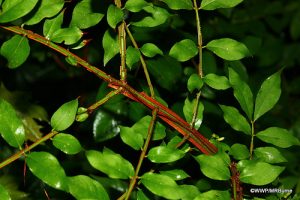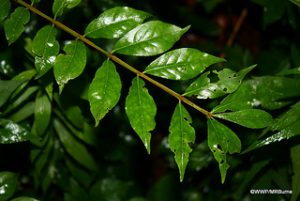Burning Bush
(Euonymus alatus)
Family: Bittersweet Family (Celastraceae)
Native Range: Japan and Central China

Overview: Deciduous shrub, regularly found in landscaped gardens. It has vibrant red fall foliage and showy bark
Size: 22 feet tall and 12 feet wide
Leaves: Opposite and elliptical in shape with toothed margins, and turn a brilliant scarlet in the fall
Stem/Bark: Corky ridges form along the green twigs, and give the branches a winged appearance
Flowers: Inconspicuous greenish flowers in late spring
Seed/Fruit: Red-purple fruits mature during summer
Roots: Dense, fibrous and relatively shallow
Reproduction: Spreads by root suckers. The fruits of burning bush are dispersed by wildlife.
Ecological Threat
It can form dense thickets, displacing many native woody and herbaceous plant species and altering the structure of natural plant communities.
Distribution and Background
Burning bush was imported from Northeastern Asia in the 1860s and sold as a landscape plant in Massachusetts until 2009 when it was put on the Prohibited Plant List. These plants are still found in landscaped beds. Burning bush is found in almost all of eastern United States.
Habitat Type
Burning bush threatens a variety of habitats including forests, coastal scrublands and prairies. It is tolerant of moist soils, and can occur in wetlands.
 Management Options
Management Options
Mechanical and chemical methods are the primary means of control of burning bush of established individuals. Hand pulling is effective for smaller individuals. For large infestations a combination of methods work best.
Biological
None
Manual
Remove young seedlings by hand to the entire root system to avoid resprouting.
Mechanical
- Regular cutting or mowing is effective in controlling burning bush (every 4-6 weeks). Cutting is most effective when combined with an application of herbicide to cut surfaces.
- A tool such as a weed wrench can be very effective in uprooting plants from the soil.
Chemical
Apply systemic herbicides like glyphosate and triclopyr to control burning bush. Make sure to use a wetland formulated herbicide such as Rodeo, Accord Concentrate, or Garlon 3A if you are working in a wetland. Foliar and cut-and-paint applications are the most effective applications.
Notice: Mention Of Pesticide Products On This Web Site Does Not Constitute Endorsement Of Any Material. See Control and Disposal Methods for descriptions of application types and warnings.
Disposal
Compost on site in a discrete pile.
Look-alikes
Burning bush may be confused with other species of euonymus.
Alternative Plants (Alternative native Species)
Many native plants make excellent substitutes for exotic bush burning bush. Some examples include:
- Black chokeberry (Aronia melanocarpa)
- Sumac (Rhus aromatica, Rhus typhina)
- Highbush blueberry (Vaccinium corymbosum)
For more information on invasive species in Massachusetts, refer to the Massachusetts Prohibited Plant List at https://www.mass.gov/massachusetts-prohibited-plant-list.